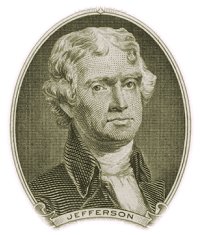 |
| The Central Banking System of America underwent quite an evolution since the Founding Fathers established our country. |
Alexander Hamilton, the first Secretary of the Treasury in George Washington's cabinet, was a major proponent of a Central Banking System. He believed in the grandeur of federal government, even to the subordination of individual interests. He succeeded in establishing the first Central Bank of the United States in 1781. |  |
Andrew Jackson, on the other hand, was against the United States having a Central Bank. It is interesting how his picture now appears on the notes of our Central Bank, i.e., Federal Reserve Notes. |  |
Thomas Jefferson, principal author of the Declaration of Independence, first Secretary of State under George Washington, and the third elected President of the United States was against a Central Banking System. Being a champion of the common people, he believed that government should not have too great a power over the economy. His picture appears on the, little circulated, $2 Bill. |  |
| Establishment of a Central Banking System | |
| The beginning of a banking system in the United States dates back to the time of the colonists fighting in the Revolutionary War, and their need for the war effort to be funded. The Continental Army desperately needed weapons and supplies, and in an effort to finance this undertaking, the Pennsylvania Bank was founded. When the Revolutionary War was over and the need for military funding subsided, the bank was later disbanded in 1784. Over the next century, prominent citizens of the new union presented their case, either for, or against the idea of having a government sponsored central bank that would monitor and regulate the amount of money in the colonial economy. In 1781, the first Secretary of the Treasury, Alexander Hamilton, was successful in convincing the Continental Congress to create our first central bank, the Bank of the United States. Thomas Jefferson and a number of other anti-banking supporters voiced strong objections to the existence of such a powerful institution. Jefferson believed that the government would exceed the power that was delegated by the Constitution if it instituted a central bank. Serving as the first Secretary of State in George Washington's cabinet, Jefferson was at odds with Hamilton over political ideologies. Jefferson was concerned about individual rights and Hamilton believed in the importance of federal power. The two opposing views established the basic foundations of our two party political system. They both retired from Washington's Cabinet near the end of his first presidential term and they continued to represent opposing political ideologies, thereafter. The Bank of the United States was a private corporation that issued its own notes. These notes were backed by the bank's holdings of gold and silver. Additional functions of the bank were to issue government securities, hold government deposits, and limit the amount of currency that was issued by state chartered banks.The charter for the Bank of the United States lasted only 20 years. The anti-banking supporters of Jefferson succeeded in blocking the action of another charter in 1811. In the War of 1812, once again, the government was unable to effectively manage the supply of money and it was unable to provide financial support of the troops. In 1816, the forces in favor of a central bank succeeded in establishing the Second Bank of the United States. TO BE CONTINUED | |
| Federal Reserve System -- Main Page | |
| History Dynamics Analytics Home | |
Copyright © 2001 BoomOnWallSt.com All Rights Reserved | |